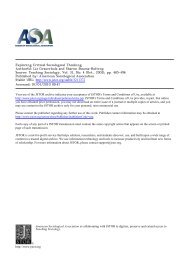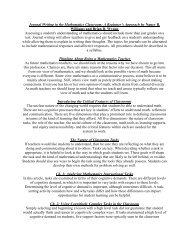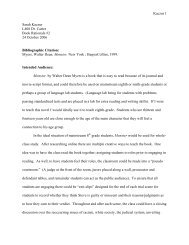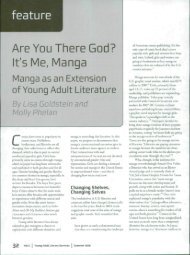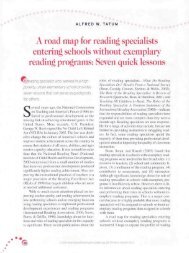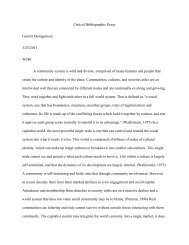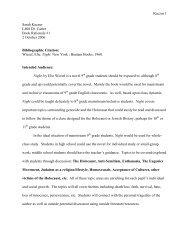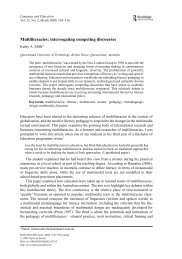Dyson 2003 Welcome to the Jam.pdf - Oncourse
Dyson 2003 Welcome to the Jam.pdf - Oncourse
Dyson 2003 Welcome to the Jam.pdf - Oncourse
You also want an ePaper? Increase the reach of your titles
YUMPU automatically turns print PDFs into web optimized ePapers that Google loves.
“<strong>Welcome</strong> <strong>to</strong> <strong>the</strong> <strong>Jam</strong>”<br />
anne haas dyson<br />
Like Marcel and Wenona’s Space <strong>Jam</strong> song, <strong>the</strong> children’s textual <strong>to</strong>ys —<br />
<strong>the</strong>ir appropriated symbolic material — had origins in <strong>the</strong>ir participation in<br />
various institutions, dominant among <strong>the</strong>m family, neighborhood, and<br />
school. Through this participation, children found human and electronically<br />
mediated material <strong>to</strong> reframe in <strong>the</strong>ir unofficial worlds. In so doing, <strong>the</strong>y<br />
authored — or brought <strong>to</strong> voice — <strong>the</strong> times and spaces of <strong>the</strong>ir own childhoods.<br />
In this section, I sample <strong>the</strong>se resources and textual processes, featuring<br />
variations and combinations of <strong>the</strong> practices of group singing and dramatic<br />
play.<br />
Singing Childhood Times and Spaces<br />
Group singing was <strong>the</strong> practice most revealing of <strong>the</strong> breadth of children’s cultural<br />
landscapes. For example, children appropriated officially sung songs for<br />
<strong>the</strong>ir own use more than any o<strong>the</strong>r kind of school material. One child would<br />
loudly begin a song, like <strong>the</strong> Mo<strong>the</strong>r Earth song for Earth Day, and that singing<br />
would recruit o<strong>the</strong>r children, who would fold in<strong>to</strong> <strong>the</strong> ongoing rhythm.<br />
The children also appropriated songs (like <strong>the</strong> Space <strong>Jam</strong> songs) first experienced<br />
in family activities, activities carried out with parental approval. More<br />
dramatically, <strong>the</strong>y appropriated and played with songs that were not directed<br />
<strong>to</strong> six-year-olds but <strong>to</strong> “teenagers.” They reported (and parents confirmed)<br />
that <strong>the</strong>y were learning <strong>the</strong>se songs primarily from radios that played in multiage<br />
households during morning routines and school commutes, in community<br />
center offices and public parks, and in <strong>the</strong> company of adolescents —<br />
cool people whom children admired.<br />
The children were quite aware that <strong>the</strong>se songs were not intended for <strong>the</strong>m.<br />
They could enact voices that suggested (and <strong>the</strong> parent session demonstrated)<br />
caregivers’ concerns about <strong>the</strong> content of certain “teenager” songs<br />
and <strong>the</strong> images <strong>the</strong>y connoted. When Denise drew herself as Tina Turner in<br />
high heels and a slinky gown, Vanessa said,<br />
I’m not putting high heels on me cause that’s <strong>to</strong>o fast, Denise. That’s <strong>to</strong>o fa::st.<br />
We’re only 6 and 7. And that is <strong>to</strong>o fast (with definiteness). ’Cause, Denise, I’m<br />
sorry if I’m breaking your heart . . .<br />
As Vanessa’s comments suggest, teenager music was associated in part with<br />
ideologies of age, and so, in fact, was music associated with preschool shows.<br />
Teenager music, though, had gender and racial reverberations that preschool<br />
songs did not. Consider, for example, <strong>the</strong> following scene.<br />
The children are making Earth Day crowns, decorated with nature scenes<br />
and sayings. There is a great deal of cutting and coloring, <strong>the</strong> sort of activities<br />
that lend <strong>the</strong>mselves <strong>to</strong> group singing. Elizabeth, Denny, Cedric, Marcel,<br />
Wenona, and Noah are all sitting at <strong>the</strong> same table. (Elizabeth and Denny are<br />
European American; all <strong>the</strong> o<strong>the</strong>rs are African American.) Marcel begins singing<br />
<strong>the</strong> Mo<strong>the</strong>r Earth song and o<strong>the</strong>rs join in. Then Marcel moves on <strong>to</strong> a different<br />
song, which he sings in a soul-full style:<br />
339



